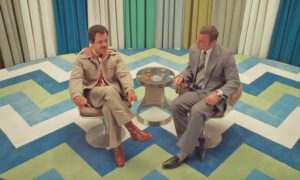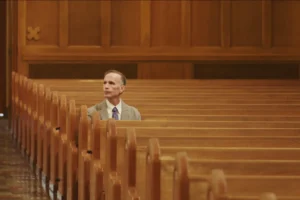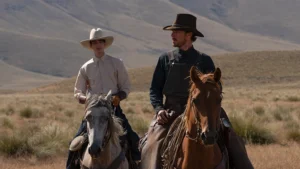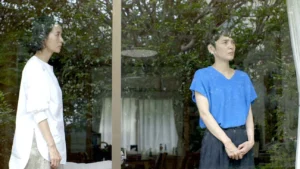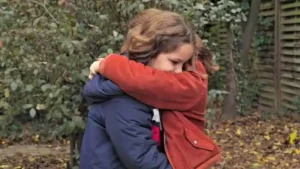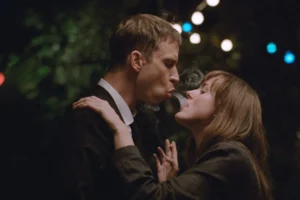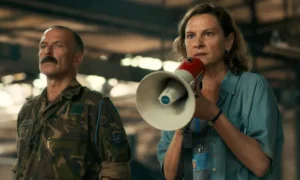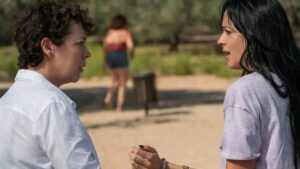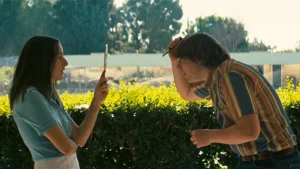At last! My favorite films of 2021. Overall, I watched 157 movies, which is a little more than I usually aim for. For this list, I’ve counted films that had an original theatrical or streaming release in the United States in 2021. Here you’ll find outcasts, misfits, miscreants, and lonely souls. But you’ll also find love and hope among the dregs, which even the most tragic cinema can offer.
As always, we shall begin with…
Honorable Mentions (in Alphabetical Order):
Bo Burnham: Inside
Drive My Car (Doraibu mai kâ)
Flee (Flugt)
Pig
Rocks
Saint Maud
Shiva Baby
There Is No Evil (Sheytan vojud nadarad)
This Is Not a Burial, It’s a Resurrection
Titane
10. The French Dispatch
Wes Anderson’s latest film sees him doubling down on all his quirks, obsessions, and idiosyncrasies while still daring to surprise us. Chronicling stories in a fictional French-based American newspaper as short films, Anderson infuses each of them with a profound sadness, even amidst the whimsy and humor. Hermetically sealed though his worlds may be, they’re anything but clean, and often rife with messiness and grime. Through caper plots, gritty prison dramas, tributes to the French New Wave, and even an animated chase sequence, we see outsiders reckoning with their place in the world. Jeffrey Wright deserves the lion’s share of praise for his James Baldwin-esque raconteur, somehow making an elaborate kidnapping conspiracy seem both totally grounded and deeply personal. Anderson’s characters always reach for something they can never quite grasp—but by telling their stories, perhaps they can get a little closer.
9. Procession
Being a huge fan of Robert Greene’s last experimental doc, Bisbee ’17, I was surprised at first by his new one’s comparative conventionalism. It was compelling for sure, but this story—following six survivors of sexual abuse who make short films as therapy—seemed rather straightforward. Then the film reminded me how deftly Greene plays with the line between reality and performance, truth and storytelling; note especially how Greene will retain cinematographic elements of a short film scene even when the directors yell “cut.” By constantly skirting that line, we see how trauma cannot be relegated to isolated moments; it fights for air in our weakest moments and strongest days. But if trauma is ubiquitous, so is the potential for healing. These men find strength through each other, seeking not to erase the past but add new dimension to it. There are no easy remedies here. Luckily, the film does not seek panacea, but progress.
8. The Power of the Dog
Jane Campion’s neo-western is a slow burn if there ever was one, owing more to Hitchcock than Peckinpah. Following a new marriage and subsequent war of psychological attrition in 1920s Montana, Campion unfolds the drama with patience and immaculate control. Rich cinematography and a spare, potent script uncover deep reservoirs within each character but never explain a precise trauma or trigger. We only have their behavior to glean any insight, keeping them fascinating but mysterious. The give-and-take in each power dynamic is a marvel to behold, and Campion’s bold visual choices never let us relax into a sense of complacency. Notice how modernity keeps intruding: a motorcar suddenly materializing to disturb a posse of horse wranglers, or the triumph of wily intellect over Old West machismo. Despite Benedict Cumberbatch’s brash and relentless persona, it’s Kodi Smit-McPhee’s dark, watchful eyes that subsume all by the end.
7. The Souvenir: Part II
Joanna Hogg’s sequel to her 2019 timepiece pulls off that rare miracle: it manages to comment upon its original source while existing as its own unique vision. Having emerged from a toxic relationship, Honor Swinton-Byrne’s Julie seeks to process it through her art. A contention with irrational feelings, a metacommentary on critical responses to the first film, and a portrait of artistic insecurity all combine in a surprisingly cohesive stew. By showcasing Julie’s artistic victories and disappointments, Hogg beautifully dispels the myth that art must come from a place of mature understanding rather than a flurry of thoughts and feelings. Interestingly, we never see Julie’s finished film, instead witnessing a dreamlike version which may have been Julie’s original vision or perhaps only one for herself. With its mature insights into artistic endeavor and a supporting cast that includes Tilda Swinton and comedian Richard Ayoade, it’s a sequel I can only hope inspires more.
6. Wheel of Fortune and Fantasy (Gûzen to sôzô)
Ryûsuke Hamaguchi’s Oscar-winning Drive My Car overshadowed his other U.S. 2021 release, which also happens to be my favorite of the two. The second anthology on my list, this trilogy of short films tells three stories of personal relationships that begin in one place before transforming into something neither participant could have imagined. Challenging and heartbreaking, each segment blends the immediacy of thoughtful conversation with the inevitability of its transience. Hamaguchi will find the exact right moment to punctuate a long take with an intimate closeup. What’s more, it offers our characters fresh opportunities to take stock of their lives. It’s a way of shocking them (and us) out of this newfound comfort to wrestle with ghosts of the past and consider the vast, infinite possibilities of the future. Hamaguchi’s film captures how moments can seem eternal—but they must, just like the film itself, come to an end.
5. Petite Maman
Céline Sciamma’s follow-up to my beloved Portrait of a Lady on Fire reduces her filmmaking scale but not her considerable powers. In 72 minutes, there’s not a shot taken lightly or moment wasted. Our young heroine, Josephine Sanz’s Nelly, makes a new friend while exploring the woods near her late grandmother’s home. The identity of this friend bestows a low-key fantasy element at just the right pitch. It’s light and whimsical, yes, but doesn’t sand off the rough edges of her family members the way other films might—we simply see them though Nelly’s eyes. The film mercilessly examines the distance between ourselves and our loved ones, scrounging for scraps of the past to illuminate the present. At times, past versions of characters belong as much to the future as they do to their own time. It’s a lovely evocation of the way time folds over and in on itself, bringing us ever closer to the precious connections we crave.
4. The Worst Person in the World (Verdens verste menneske)
Don’t let the title fool you; Joachim Trier and company mean it in hyperbolic fashion. If it refers to anything, it’s the mess that our protagonist, Renate Reinsve’s Julie, leaves in her wake, struggling to figure out her life through the lens of her romantic entanglements. Framed as a kind of memory play, the film has a deliberate, self-aware construction, as if Julie herself were behind every aspect of its creation. She has the space and freedom to play out her spontaneous desires, mistakes, and newfound joys on an open canvas. Sometimes the film prioritizes momentary fulfillment over sustainment, shifting from grounded, vérité-style meet-cutes to limitlessly inventive fantasias. After all, the world never conforms to the thicket of emotions we actually feel. There is meaning and consequence to these moments, even selfish ones, the film argues. It’s a paean to all the terrible, wonderful decisions we make (and wish we could make).
3. Quo Vadis, Aida?
Jasmila Žbanić’s devastating Bosnian War drama plays like a slow-motion tragedy, fully immersing us in the horror and absurdity of genocide. Following a UN Bosnian translator with immunity from persecution (something her community lacks), it details in painstaking detail how people compartmentalize horror for sanity’s sake—until they can’t. Žbanić gives us perfect clarity for each player in the conflict; we see the unfurling futility of the UN peacekeepers, gradually ceding power as the invading Serb Army essentially calls their bluff. This latter entity has a cold, practical logic to its horrifying mission, one that employs performative mercy as a cover for psychopathic gain. At the same time, Jasna Đuričić’s Aida makes concession after concession, even as it becomes increasingly clear she’s about to lose everything. If it sounds devastating, it is—but it reminds us precisely how horrors like these continue to happen.
2. The Lost Daughter
With creeping menace, Maggie Gyllenhaal’s psychological character study accounts for ugly choices that nonetheless speak to universal feelings. When Olivia Colman’s vacationing Leda encounters a young mother played by Dakota Johnson, old memories (and old wounds) resurface, both in flashbacks and Leda’s increasingly odd behavior in the present. Gyllenhaal makes excellent use of soft focus and unnerving closeups to create a claustrophobic hyperreality; everyone is just a little too probing in their line of questioning, heightening the paranoia. The film handles tonal shifts as deftly as its amazing cast (at one point, Colman manages to turn a full-on sob into a bright-eyed chuckle). It would be easy to see another film that simply punishes Leda for the choices she’s made, but Gyllenhaal and company aspire to nothing so simple, delving into the murky chasms and contradictions of Leda’s soul that thrive well beyond her darkest secrets.
1. Licorice Pizza
A Paul Thomas Anderson film as my number 1? You’re shocked, I’m sure! But hear me out: consider the texture here. The vibes. The bitterness of a savage world and the sweet promise still hidden within it. Set in Anderson’s trademark 1970s San Fernando Valley milieu, it’s a lovingly shaggy ramble, a coming-of-age two-hander with perfectly realized performances from our two newbie leads. Cooper Hoffman’s Gary and Alana Haim’s Alana confront the world head-on, trying (and often failing) to see where they fit. And its diverse characters (washed-up has-beens or never-has-beens) color the film with unwitting lessons of their own. The film plays lovingly with pacing, the way people flit in and out of our lives, and the way the world can make absolute sense before it completely collapses, over and over. Somehow Anderson makes 1970s Los Angeles seem nostalgic in a way that doesn’t cut away its apathies, its cruelties, or its hard-worn wisdom.
And with that, 2021 comes to a close (for me at least). I look forward to sharing my thoughts on the best of 2022, eons hence…
